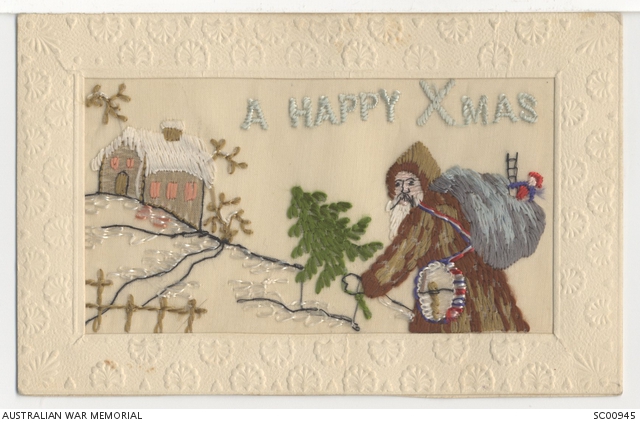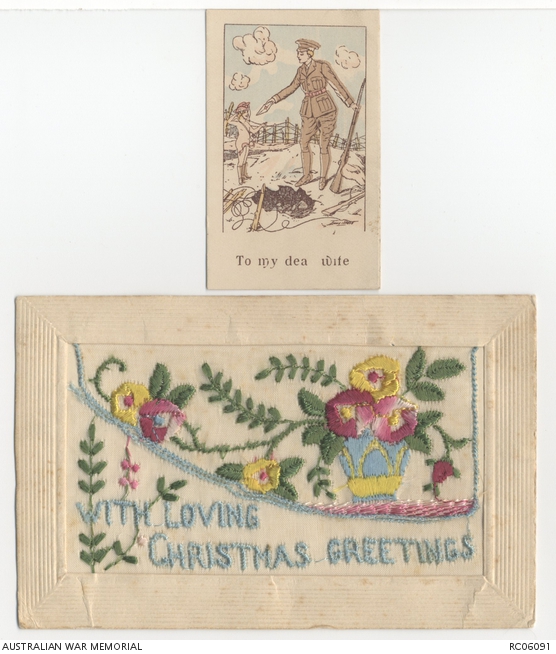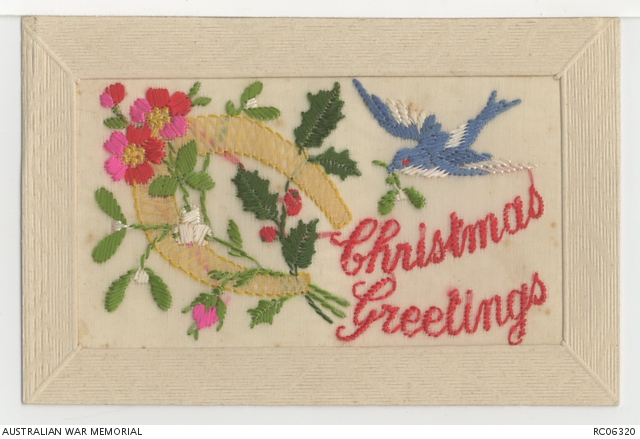"With loving Christmas greetings"
The sending of a traditional Christmas card has diminished in popularity with the advent of mobile phones, email and social media. The Australian War Memorial has a large collection of postcards and greeting cards sent to and from Australian service personnel engaged in conflicts from the South African War (1898 – 1902) to Afghanistan (2001 – present). During the First World War, a very popular design of greeting card was the woven or embroidered silk postcard.
Woven silk postcards were first produced in Krefeld, Germany in 1898. They were a combination of printed postcards and woven silk pictures, known as Stevengraphs. Woven postcards were machine made and maintained a high standard. Embroidered silk postcards were first exhibited at the 1900 Paris Exhibition. Many embroidered silk postcards were hand embroidered onto rolls of silk, by women in France and Belgium. They were then cut and mounted in factories.
Woven and embroidered silk postcards gained immense popularity with soldiers during the First World War, with troops posting them to their families, friends or sweethearts. Postcards featured a variety of motifs and designs, with many featuring a patriotic theme. As popularity and production grew, quality of some cards did decline somewhat.
It is estimated that during the years 1914 to 1919, approximately 10 million silk postcards were produced. They continued to be made until the 1940s, though did not reach the same heights of popularity as during the First World War.
The Australian War Memorial has a collection of over 700 woven, printed and embroidered silk postcards, with over 80 featuring a Christmas or New Year theme. Here’s a few of our favourites.
Embroidered silk postcard made in France during the First World War. This postcard features Santa Claus carrying a bag of toys and a Christmas tree whilst walking up a slope towards a small cottage in the snow.
Embroidered silk postcard made in France during the First World War. Of envelope design, this postcard features a vase of yellow and pink flowers and greenery. A small card insert features the message "To My Dear Wife", illustrated with a picture of a soldier handing a letter to a cherub.
Embroidered silk postcard made in France during the First World War. Of envelope design, this postcard features pink rosebuds, violets and butterflies with blue wings. A small card insert features the message "To my Dear Mother", illustrated with purple flowers and a chicken.
Embroidered silk postcard made in France during the First World War. This postcard features a horseshoe with sprigs of holly, mistletoe and roses. Also featuring in the design is a bluebird carrying a small sprig of mistletoe.
Woven silk postcard made in France during the First World War. This postcard features snow falling upon a green tree with red and green baubles. A small insert beside the tree shows four birds flying over a village.
Woven silk postcard made in France during the First World War. This postcard features snow falling on a church and three pine trees.
Embroidered silk postcard made in France during the First World War. This postcard features a string of brightly coloured tolling bells above a cottage and palm trees. A shooting star also appears in the design.
Embroidered silk postcard made in France during the First World War. This postcard features two birds above a chimney and roof covered in snow and decorated with sprigs of holly and mistletoe.







